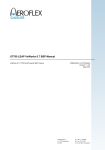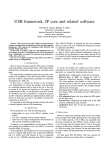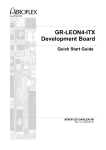Download LEON Linux User`s Manual
Transcript
.
LEON Linux User's Manual
1
LEON Linux User's Manual
LEON specific Linux documentation
LINLEON
Version 1.0.1
April 2015
Kungsgatan 12
413 11 Gothenburg
Sweden
tel +46 31 7758650
fax +46 31 421407
www.aeroflex.com/gaisler
LEON Linux User's Manual
LEON Linux User's Manual
Copyright © 2014 Aeroflex Gaisler AB
2
LEON Linux User's Manual
iii
Table of Contents
1. Introduction ...................................................................................................................... 1
1.1. Conventions in this document ................................................................................... 1
2. Configuring the Linux Kernel .............................................................................................. 2
3. Subsystems and drivers ...................................................................................................... 3
3.1. CAN subsystem ...................................................................................................... 3
3.1.1. Kernel configuration for CAN ........................................................................ 3
3.1.2. GRCAN and GRHCAN driver ........................................................................ 4
3.1.3. CAN_OC driver ........................................................................................... 4
3.1.4. CAN kernel space interface ............................................................................ 5
3.1.5. CAN user space interface .............................................................................. 5
3.1.6. CAN in Buildroot ......................................................................................... 5
3.2. Ethernet subsystem ................................................................................................. 5
3.2.1. GRETH 10/100 and GBIT driver .................................................................... 5
3.3. Framebuffer subsystem ............................................................................................ 6
3.3.1. Kernel configuration for framebuffer ................................................................ 6
3.3.2. SVGACTRL driver ....................................................................................... 6
3.4. GPIO subsystem ..................................................................................................... 6
3.4.1. Kernel configuration for GPIO ........................................................................ 6
3.4.2. GRGPIO driver ............................................................................................ 7
3.4.3. GPIO kernel space interface ........................................................................... 8
3.5. I2C subsystem ........................................................................................................ 8
3.5.1. Kernel configuration for I2C .......................................................................... 8
3.5.2. I2CMST driver ............................................................................................ 8
3.5.3. I2C user space interface ................................................................................ 9
3.5.4. I2C in Buildroot ........................................................................................... 9
3.6. PCI subsystem ....................................................................................................... 9
3.6.1. Kernel configuration for PCI .......................................................................... 9
3.6.2. GRPCI driver .............................................................................................. 9
3.6.3. GRPCI2 driver ............................................................................................. 9
3.7. PS/2 subsystem ..................................................................................................... 10
3.7.1. Kernel configuration for PS/2 ....................................................................... 10
3.7.2. APBPS2 driver ........................................................................................... 10
3.8. SPI subsystem ...................................................................................................... 10
3.8.1. Kernel configuration for SPI ......................................................................... 10
3.8.2. SPICTRL driver ......................................................................................... 10
3.9. TTY subsystem ..................................................................................................... 12
3.9.1. Kernel configuration for TTY ....................................................................... 12
3.9.2. APBUART driver ....................................................................................... 12
3.9.3. Mklinuximg configuration ............................................................................ 12
3.10. USB device subsystem ......................................................................................... 13
3.10.1. Kernel configuration for USB device ............................................................ 13
3.10.2. GRUSBDC driver ..................................................................................... 13
3.11. USB host subsystem ............................................................................................ 13
3.11.1. Kernel configuration for USB host ............................................................... 14
3.11.2. GRUSBHC EHCI driver ............................................................................ 14
3.11.3. GRUSBHC UHCI driver ............................................................................ 14
4. Frequently Asked Questions .............................................................................................. 15
4.1. What causes DMA-API warnings on addresses 0xf0005000-0xf0007fff? .......................... 15
5. Support .......................................................................................................................... 16
6. Disclaimer ...................................................................................................................... 17
LEON Linux User's Manual
1
1. Introduction
This document contains documentation on configuring the Linux kernel, and configuring and using device
drivers for Aeroflex Gaisler IP cores.
Additional information can be found in the LEON Linux overview document, in the documentation for the
LINUXBUILD linux build environment, the mklinuximg RAM loader tool and the external driver package
documentation.
1.1. Conventions in this document
When describing configuration options, both the descriptive name of the option and the variable name of the
option is mentioned, the first in quotation marks and the latter within parenthesis. E.g., when configuring
the kernel for LEON, the option described as “Sparc Leon processor family” should be chosen. This
configuration option has the varible name “SPARC_LEON”. This is mentioned as “Sparc Leon processor
family” (SPARC_LEON). Searches in the configurators (xconfig, gconfig, menuconfig) are matching agains
the variable names.
Descriptions on where to find an configuration option to be chosen are often in relation to earlier selections.
E.g., in the description on how to select a driver for a specific core, the description on where to find it is
often described in relation to where the subsystem was configured.
Chapter 3 contains descriptions for setting up extra nodes and/or properties in the devicetree for several cores
using mklinuximg. These xml files are used with the -xml option of mklinuximg. See the Mklinuximg
manual for details.
LEON Linux User's Manual
2
2. Configuring the Linux Kernel
This chapters gives the bare minimum for configuring the Linux kernel for LEON. The configurations
from the leon-linux kernel packages contains suitable default configurations to use as a starting point. See
Chapter 3 for configuration of device drivers for Aeroflex Gaisler IP cores.
When configuring the kernel make sure to specify ARCH=sparc when starting the configurator (e.g. make
ARCH=sparc xconfig).
Make sure that
• “64-bit kernel” (64BIT)
is not selected at top level. Then select
• “Sparc Leon processor family” (SPARC_LEON)
under “Processor type and features”.
To build an SMP kernel, also select
• “Symmetric multi-processing support” (SMP)
under “Processor type and features”.
LEON Linux User's Manual
3
3. Subsystems and drivers
This Chapter contains documentation about drivers included in the Linux mainline kernel. The chapter is
organized per kernel subsystem and contains information on configuring the subsystem, configuring and
drivers in that subsystem, information on kernel and user space interfaces and notes on using them in the
Buildroot environment.
See separate document for drivers provided in the GRLIB Driver Package available from http://gaisler.com.
Table 3.1. Overview of Cores and Drivers
Core
Section
Linux 3.10 Source Path
Comments
APBPS2
Section 3.7.2
drivers/input/serio/
apbps2.c
In mainline since v3.10
APBUART
Section 3.9.2
drivers/tty/serial/
apbuart.c
In mainline since v2.6.33
CAN_OC
Section 3.1.3
drivers/net/can/sja1000/
sja1000_of_platform.c
In mainline since v3.8
GRCAN
Section 3.1.2
drivers/net/can/grcan.c
In mainline since v3.8
GRETH/
GRETH_GBIT
Section 3.2.1
drivers/net/ethernet/
aeroflex/greth.c
In mainline since v2.6.34
GRGPIO
Section 3.4.2
drivers/gpio/gpio-grgpio.c In mainline since v3.10
GRHCAN
Section 3.1.2
drivers/net/can/grcan.c
In mainline since v3.8
GRPCI
Section 3.6.2
arch/sparc/kernel/
leon_pci_grpci1.c
In mainline since v3.10
GRPCI2
Section 3.6.3
arch/sparc/kernel/
leon_pci_grpci2.c
In mainline since v3.0
GRSPW2
Separate
document
drivers/grlib/spw/grspw.c
In GRLIB Driver Package
GRSPW2_
ROUTER
Separate
document
drivers/grlib/spw/
grspw_router.c
In GRLIB Driver Package
GRUSBDC
Section 3.10.2 drivers/usb/gadget/
gr_udc.c
GRUSBHC
Section 3.11.2 drivers/usb/host/{e,u}hci- In mainline since v3.0
&
grlib.c
Section 3.11.3
I2CMST
Section 3.5.2
drivers/i2c/busses/i2cocores.c
In mainline since v3.8
SVGACTRL
Section 3.3.2
drivers/video/grvga.c
In mainline since v3.2
SPICTRL
Section 3.8.2
drivers/spi/spi-fsl-spi.c
In mainline since v3.10
Available in leon-linux-3.10;
in mainline since v3.14
3.1. CAN subsystem
General documentation about CAN in Linux can be found in Documentation/networking/
can.txt in the Linux kernel source tree.
3.1.1. Kernel configuration for CAN
Enable CAN support in the Linux kernel by selecting:
• “CAN bus subsystem support” (CAN)
under “Networking support”
Under this section select the following options:
LEON Linux User's Manual
4
• “Raw CAN Protocol” (CAN_RAW)
• “Platform CAN drivers with Netlink support” (CAN_DEV)
• “CAN bit-timing calculation” (CAN_CALC_BITTIMING)
3.1.2. GRCAN and GRHCAN driver
The GRCAN and GRHCAN driver supports listen-only mode, triple samling mode (when available in the
core), and one-shot mode. The driver follows the standard Linux CAN interface.
3.1.2.1. Kernel configuration
To use GRCAN and/or GRHCAN, select:
• “Aeroflex Gaisler GRCAN and GRHCAN CAN devices” (CAN_GRCAN)
under “CAN Device drivers”.
The default values of the enable0, enable1 and select bits of the configuration register and the tx and rx
buffer sizes can be configured via kernel paramenters listed in Table 3.2.
Table 3.2. Kernel Parameters
Parameter
Default Description
grcan.enable0 0
Default configuration of physical interface 0. Configures the “Enable 0”
configuration register bit
grcan.enable1 0
Default configuration of physical interface 1. Configures the “Enable 1”
configuration register bit
grcan.select
0
Default configuration of physical interface selection. Configures the “Select” bit
of the configuration register.
grcan.txsize
1024
Configures the size of the tx buffer in bytes.
grcan.rxsize
1024
Configures the size of the rx buffer in bytes.
For example, adding grcan.enable0=1 to the kernel command line will set the default for enable0
to 1, and keep 0 as the the default for enable1. The settings for enable0, enable1 and select settings
can be overriden at runtime, whereas txsize and rxsize can not. The kernel parameters values can be
read at runtime from /sys/module/grcan/parameters/. See also Documentation/kernelparameters.txt in the Linux kernel source tree.
3.1.2.1.1. Runtime Configuration
The enable0, enable1 and select bits of the configuration register can be set at runtime via the sysfs file system
under /sys/class/net/canX/grcan/, where canX is the interface name of the device in Linux. For
example, echo 1 > /sys/class/net/can0/grcan/enable0 will set the enable0 bit of interface can0 to 1. See
also Documentation/ABI/testing/sysfs-class-net-grcan in the Linux kernel source tree.
3.1.3. CAN_OC driver
CAN_OC cores use an SJA1000 driver in Linux. Only PeliCAN mode is supported. The driver supports
listen-only mode, triple samling mode, one-shot mode and bus-error reporting. The driver follows the
standard Linux CAN interface.
3.1.3.1. Kernel configuration
To use CAN_OC, select:
• “Philips/NXP SJA1000 devices” (CAN_SJA1000)
• “Generic OF Platform Bus based SJA1000 driver” (CAN_SJA1000_OF_PLATFORM)
3.1.3.2. Open Firmware device tree details for CAN_OC
One core can contain several CAN_OC instantiations. The “version” property plus one in the AMBA
Plug&Play indicates the number of CAN_OC instantiations. However, mklinuximg creates separate virtual
LEON Linux User's Manual
5
devices for the Open Firmware device tree. So from the Linux kernel point of view every instantiation is a
separate device. The nodes are called “GAISLER_CANAHB” in the device tree.
3.1.4. CAN kernel space interface
Not applicable
3.1.5. CAN user space interface
CAN devices is accessed in Linux as network interfaces, via sockets. The interfaces are named can0,
can1, etc. The available CAN interfaces can be seen by running /sbin/ip link. Bitrate or specific bittiming
parameters are set up from within Linux using the /sbin/ip command. Run /sbin/ip link set canX type can
help (with X substituted by appropriate number) to see the configuration parameters available. Some listed
parameters might not be available for particular drivers/hardware. Bringing a CAN interface canX up and
down can be done by ifconfig canX up and ifconfig canX up respectively. Bittiming parameters needs to
be set before bringing a CAN interface up the first time.
See Documentation/networking/can.txt in the Linux kernel source tree for more details on
configuration and the CAN specific configuration parameters of /sbin/ip. Note: as of Linux 3.8, hardware
filtering is not supported in Linux.
3.1.5.1. The can-utils toolset
The can-utils toolset can be used as quick testing and diagnostics tools and the source code also serves as
examples on socket programming for CAN interfaces.
The following example sets up interface can0 at 125 kbps, enables the interface, starts candump with
parameters set to receive any can frames including error frames and sends a frame using on the CAN bus
that is received by candump:
#
#
#
#
/sbin/ip link set can0 type can bitrate 125000
/sbin/ifconfig can0 up
candump -e any,0:0,#FFFFFFFF &
cansend can0 123#abcdef
can0 123 [3] AB CD EF
Note that if there are no other active devices on the bus, the transmit fails even if a local candump is listening
to the socket. In the case above, where one-shot mode has not been specified, the controller would retry until
it ends up in an error-passive state and error frame(s) would instead be delivered to candump.
3.1.6. CAN in Buildroot
The built-in ip command of BusyBox can not currently handle all CAN configuration options. The iproute2
package provides a working /sbin/ip. Under “Network applications” select:
• “iproute2” (BR2_PACKAGE_IPROUTE2)
The “can-utils” package contains the can-utils toolset (see Section 3.1.5.1). Under “Network applications”
select:
• “can-utils” (BR2_PACKAGE_CAN_UTILS)
3.2. Ethernet subsystem
No attempt is made here to try to cover Ethernet and networking for Linux in general.
3.2.1. GRETH 10/100 and GBIT driver
3.2.1.1. Kernel configuration
When configuring the kernel, select:
LEON Linux User's Manual
6
• “Aeroflex Gaisler GRETH Ethernet MAC support” (GRETH)
under “Ethernet driver support”.
The MAC address of the first GRETH core can be set up by a kernel module parameter (described below)
or in the ID prom (desbribed under mklinuximg configuration further down), where the module parameter
takes precedence. Th last byte of the MAC address will get increase for each following GRETH core.
Table 3.3. Kernel Parameters
Parameter
Default
Description
greth.debug
-1
Bitmask deciding which types of messages the GRETH driver should emit.
See the NETIF_MSG_* enums in include/linux/netdevice.h in the
Linux kernel source tree for the different bits. (It can later be set from userspace
using the ethtool utility. It is there called msglvl.)
greth.macaddr 0,0,0,0,0,0 Default MAC address (on the form 0x08,0x00,0x20,0x30,0x40,0x50) of the
first GRETH. If this is all zeroes the ID prom is instead used. See on
mklinuximg below for how to set it there.
greth.edcl
1
Whether EDCL is used. Is used to determine if PHY autonegotiation is to be
done right away or not.
3.2.1.2. Mklinuximg configuration
The default MAC address for the first GRETH core can be set in the ID prom from mklinuximg by using the
-ethmac flag. The kernel module parameter of the driver descruibed above takes precedence over this setting.
3.3. Framebuffer subsystem
See Documentation/fb in the Linux kernel source tree for general documentation about the framebuffer
subsystem and its kernel and user space interfaces in Linux.
3.3.1. Kernel configuration for framebuffer
Enable framebuffer support in the Linux kernel by selecting:
• “Support for frame buffer devices” (FB)
under “Grahics support” under “Device drivers”.
3.3.2. SVGACTRL driver
The SVGACTRL driver follows the standard Linux kernel framebuffer interface.
When configuring the kernel, select:
• “Aeroflex Gaisler framebuffer support” (FB_GRVGA)
under “Support for frame buffer devices”.
3.4. GPIO subsystem
See Documentation/gpio.txt in the Linux kernel source tree for general documentation about the
GPIO subsystem and its kernel and user space interfaces in Linux. See also devicetree/bindings/
gpio/gpio.txt for documentation on devicetree representations.
3.4.1. Kernel configuration for GPIO
Enable GPIO support in the Linux kernel by selecting:
• “GPIO Support” (GPIOLIB)
under “Device Drivers”.
LEON Linux User's Manual
7
3.4.2. GRGPIO driver
The GRGPIO driver follows the standard Linux GPIO interface, including setting up GPIO usage from other
devices in the devicetree.
3.4.2.1. Kernel configuration
When configuring the kernel, select:
• “Aeroflex Gaisler GRGPIO support” (GPIO_GRGPIO)
under “GPIO Support”.
3.4.2.2. Mklinuximg configuration
The GRGPIO driver needs special devicetree properties. Mklinuximg from version 2.0.6 have support for
generating them from explicitely specified information or from autoprobing the core (when possible).
The following options all take a comma-separated list of values with one value for each GRGPIO core
in the system (in scan order). The -gpio-irqgen option specifies the irqgen generic for each core.
Autoprobing can not distinguish between 0 and 1. The -gpio-nbits option specifies the nbits generic
for each core — i.e. the number of GPIO lines. The -gpio-imask option specifies the imask generic for
each core — i.e. which GPIO lines have interrupt support. The -gpio-noprobe option makes sure that
no autoprobing is being done. Otherwise probing is done for information not specified by the above options.
3.4.2.3. Mklinuximg configuration for GPIO users
It is possible for some drivers that uses GPIO to specify in the devicetree which GPIO core and GPIO line
that should be used by setting up an array property containing GPIO information for the GPIO lines to use.
Each GPIO line used needs three entries in the array. The first entry is a handle to the GPIO core. This handle
to the GPIO core is realized in mklinuximg by using the corelabel and corehandle tags. The second entry is
the offset within the GPIO core (i.e. which GPIO line of the core to use). The third entry is a bitmask. Set
bit 0 in the bitmask to 1 if the GPIO line is active-low.
The following example sets up some LED:s connected to the first GRGPIO to be used by the “default on”
and “heartbeat” LED trigger drivers.
<?xml version="1.0"?>
<matches>
<match-core vendor="VENDOR_GAISLER" device="GAISLER_GPIO" index="0">
<corelabel name="gpio0"/> <!-- For user to refer to this core -->
<!-- Set up user that could be placed elsewhere -->
<add-node name="exampleleds"> <!-- irrelevant name -->
<add-prop name="compatible">
<string>gpio-leds</string> <!-- Matches leds-gpio driver -->
</add-prop>
<add-node name="led0">
<add-prop name="default-state">
<string>on</string>
</add-prop>
<add-prop name="linux,default-trigger">
<string>default-on</string> <!-- use the default-on trigger driver -->
</add-prop>
<add-prop name="gpios">
<corehandle ref="gpio0"/> <!-- Use "gpio0" -->
<int>27</int> <!-- Use GPIO line 27 -->
<int>0</int>
</add-prop>
</add-node>
<add-node name="led0">
<add-prop name="default-state">
<string>keep</string>
</add-prop>
<add-prop name="linux,default-trigger">
<string>heartbeat</string> <!-- use the heartbeat trigger driver -->
</add-prop>
<add-prop name="gpios">
<corehandle ref="gpio0"/> <!-- Use "gpio0" -->
<int>28</int> <!-- Use GPIO line 28 -->
LEON Linux User's Manual
8
<int>0</int>
</add-prop>
</add-node>
</match-core>
</matches>
The example sets the “exampleleds” up as a child node of the GRGPIO core, but that is not necessary. Here
two different LED trigger drivers uses the leds-gpio driver that in turn uses GRGPIO. The example depends
on “LED support”, “LED Class support”, “LED Trigger support”, “LED Support for GPIO connected
LEDs”, “LED Heartbeat trigger”, “LED Heartbeat Trigger” and “LED Default ON Trigger” being enabled
for the kernel.
For another example of setting up GPIO usage, see Section 3.8.2.1.
3.4.3. GPIO kernel space interface
See Documentation/gpio.txt in the Linux kernel source for documentation on the general GPIO
interface. See include/linux/of_gpio.h for details on how to get from the devicetree the gpio
numbers used in the general kernel interface.
2
3.5. I C subsystem
See Documentation/i2c in the Linux kernel source tree for general documentation about the I2C
subsystem and its kernel and user space interfaces in Linux.
2
3.5.1. Kernel configuration for I C
Enable I2C support in the Linux kernel by selecting:
• “I2C support” (I2C)
under “Device Drivers”
3.5.2. I2CMST driver
I2CMST cores use the “I2C Open Cores” driver in Linux. The driver follows the standard Linux I2C
interface, including registering devices through the device tree.
When configuring the kernel, select:
• “OpenCores I2C Controller” (I2C_OCORES)
under “I2C Hardware Bus support”.
3.5.2.1. Mklinuximg configuration
The I2CMST driver needs special devicetree properties. Mklinuximg from version 2.0.4 and onward adds
these automatically.
To connect a I2C slave device to a I2C master through the device tree, a node for the slave device, containing
some properties, should be put as a child of the node for the master device. A “register” property should
contain the address of the slave on the I2C bus and a “compatile” property should contain the name in the
struct i2c_device_id of the slave device driver.
The following example xml file for mklinuximg adds a Dallas DS1672 real time clock as a I2C slave device
with chip address 0x68 to the device tree under the first I2CMST core:
<?xml version="1.0"?>
<matches>
<match-core vendor="VENDOR_GAISLER" device="GAISLER_I2CMST" index="0">
<add-node name="rtc"> <!-- irrelevant name -->
<add-prop name="reg">
<int>0x68</int> <!-- chip address -->
</add-prop>
<add-prop name="compatible">
<string>ds1672</string> <!-- match with driver -->
</add-prop>
</add-node>
LEON Linux User's Manual
9
</match-core>
</matches>
2
3.5.3. I C user space interface
3.5.3.1. The i2c-tools toolset
The i2c-tools toolset is useful for quick testing and diagnostics of I2C in Linux and the source code also
serves as examples on I2C programming from user space. Run the i2cdetect, i2cget, i2cset and i2cdump
commands without parameters to get rudimentary documentation.
Warning: These commands can, quoting from the man page, “be extremely dangerous if used improperly”.
2
3.5.4. I C in Buildroot
The “i2c-tools” package contains the i2c-tools toolset (see Section 3.5.3.1). Under “Hardware handling”
select:
• “i2c-tools” (BR2_PACKAGE_I2C_TOOLS)
Man pages for the tools in the toolset can be found under the tools directory of the i2c-tools build directory
(e.g. build/i2c-tools-3.0.3/tools/i2cdetect.8) and can be used by using man -l.
3.6. PCI subsystem
See Documentation/PCI in the Linux kernel source tree for general documentation about the PCI
subsystem and its kernel and user space interfaces in Linux.
The Linux PCI Host layer on a LEON system is used to perform device discovery using PCI Plug & Play,
enumerating PCI buses found, allocating the PCI address space and basic device initialization. Its up to the
PCI host bridge driver to set up and start the initialization. The LEON host bridge drivers assume that PCI
have not been initialized by the bootloader since before.
The Linux PCI Host layer on a LEON system is used to perform device discovery using PCI Plug & Play,
enumerating PCI buses found, allocating the PCI address space and basic device initialization. Its up to the
PCI host bridge driver to set up and start the initialization. The LEON host bridge drivers assume that PCI
have not been initialized by the bootloader since before.
Note
This section only describes the LEON acting as a PCI Host. There is no specific support for PCI
peripheral mode. In peripheral mode, the host typically has a driver for the LEON peripheral which
communicates over the LEON peripheral main memory.
3.6.1. Kernel configuration for PCI
Enable PCI support in the Linux kernel by selecting:
• “Support for PCI and PS/2 keyboard/mouse” (PCI)
under “Bus options (PCI etc.)”
3.6.2. GRPCI driver
When configuring the kernel, select:
• “GRPCI Host Bridge Support” (SPARC_GRPCI1)
under “Bus options (PCI etc.)”
3.6.3. GRPCI2 driver
When configuring the kernel, select:
• “GRPCI2 Host Bridge Support” (SPARC_GRPCI2)
under “Bus options (PCI etc.)”
LEON Linux User's Manual
10
3.6.3.1. Mklinuximg configuration
The GRPCI2 PCI Host bridge driver take configuration options controlled from the device tree. The
configuration options are described in the table below.
Table 3.4. GRPCI2 device tree properties
Name
Type
Default
Description
barcfg
12 words
-1=Auto
Optional custom Target BAR configuration. The configuration
property is an array of length 12 32-bit words, each pair of words
describe one PCI target BAR set up. The first word in a pair describes
the PCI address of BAR_N and the second the AMBA AHB base
address translated into. The Target BAR size is calculated from the PCI
BAR alignment.
irq_mask
word
0=All
Limit which PCI interrupts are enabled. By default all are enabled. This
property is typically used when one or more PCI interrupt pins are not
used, or must be used when they are floating on the PCB. The property
is a 4-bit mask where bit N controls Interrupt N. 0=Disable, 1=Enable.
• bit0 = PCI INTA#
• bit1 = PCI INTB#
• bit2 = PCI INTC#
• bit3 = PCI INTD#
reset
word,
boolean
0=no-rst
Force PCI reset on startup. If the property value is set to non-zero the
GRPCI2 host driver will use the GRPCI2 register interface to reset the
PCI bus on boot.
3.7. PS/2 subsystem
3.7.1. Kernel configuration for PS/2
Enable PS/2 support in the Linux kernel by selecting:
• “Serial I/O support” (SERIO)
under “Hardware I/O ports” under “Input device support” under “Device drivers”.
3.7.2. APBPS2 driver
The APBPS2 driver follows the standard Linux kernel PS/2 interface;
When configuring the kernel, select:
• “GRLIB APBPS2 PS/2 keyboard/mouse controller” (SERIO_APBPS2)
under “Hardware I/O ports”.
3.8. SPI subsystem
The SPI subsystem in Linux only has support for SPI masters. See Documentation/spi in the Linux
kernel source tree for general documentation about the SPI subsystem and its kernel and user space interfaces
in Linux.
3.8.1. Kernel configuration for SPI
Enable SPI support in the Linux kernel by selecting:
• “SPI support” (SPI)
under “Device Drivers”.
3.8.2. SPICTRL driver
The driver for SPICTRL is integrated with the driver for the Freescale SPI controller. The driver follows the
standard Linux SPI interface, including registering devices through the device tree.
LEON Linux User's Manual
11
When configuring the kernel, select:
• “Freescale SPI controller and Aeroflex Gaisler GRLIB SPI controller” (SPI_FSL_SPI)
under “SPI support”.
For the chipselect signal, the SPICTRL driver can use a combination of the slave select register of SPICTRL
core (if available) and external GPIO cores (if configured). Each on the SPI bus where SPICTRL is the master
has a chipselect number. If the slave select register is available, the slave select register will be used by default
for chipselect numbers [0, slvselsz-1], where slvselsz is the number of slave select signals of the SPICTRL
core. For other chipselect numbers, the default behavior of the driver is to do nothing (i.e. an always driven
chipselect signal would be needed). The driver can be configured to use the GPIO subsystem to drive
chipselect signals for some chipselect numbers. See Documentation/devicetree/bindings/
spi/spi-bus.txt on needed devicetree nodes and properties for chipselects and slave devices and see
below on how to realize this using mklinuximg.
3.8.2.1. Mklinuximg configuration
The SPICTRL driver needs special devicetree properties. Mklinuximg from version 2.0.4 and onward adds
these automatically.
To make the SPICTRL driver use a GPIO core to handle some or all of the chipselect signals an array
property named “cs-gpios”. A chipselect that uses the default behavior (i.e. slave select register or always
selected) should have one entry in the array containing 0. A chipselect that uses a GPIO line should have
three entries in the array. The first entry is a handle to the GPIO core and is guaranteed to not be 0. This
handle to the GPIO core is realized in mklinuximg by using the corelabel and corehandle tags. The second
entry is the offset within the GPIO core (i.e. which GPIO line of the core to use). The third entry is a bitmask.
Typically (e.g. for the GRGPIO core), set bit 0 in the bitmask to 1 if the GPIO line is active-low.
Note that there is no way to know directly from chipselect number where in the array the corresponding
entry or entries are. They are put one after another and are distinguished by if the first entry is 0 or not. The
array is optional. If not present all chipselect numbers use the default behavior. The array can also be short.
Any chipselect number with no entry in the array will use the default behavior.
To connect a SPI slave device to a SPI master through the device tree, a nodefor the slave device, containing
some properties, should be put as a child of the node for the master device. A “register” property should
contain the chipselect number address of the slave, a “compatible” property should contain a name that is
matched by the driver of the slave, and a “spi-max-frequency” property should contain maximum clocking
frequency of the slave. The drivers also supports the optional “spi-cpha”, “spi-cpol” and “spi-lsb-first”
properties that are added as empty properties. See Documentation/devicetree/bindings/spi/
spi-bus.txt for details.
The following example xml file for mklinuximg sets up the first SPICTRL core to use default chipselect
behavior for chipselect numbers 0 and 2, and to use GPIO line 27 of the first GRGPIO core for chipselect
number 1. It also adds a AD7814 temperature sensor SPI slave device with chipselect number 0 to the device
tree under this SPICTRL core (that would need a driver matching “adi,ad7814”).
<?xml version="1.0"?>
<matches>
<match-core vendor="VENDOR_GAISLER" device="GAISLER_SPICTRL" index="0">
<!-- chipselect setup -->
<add-prop name="cs-gpios">
<!-- chipselect 0: default -->
<int>0</int>
<!-- chipselect 1: line 27 of "gpio0" -->
<corehandle ref="gpio0"/>
<int>27</int>
<int>0</int>
<!-- chipselect 2: default -->
<int>0</int>
</add-prop>
<!-- SPI slave -->
<add-node name="ad7814">
<add-prop name="reg">
<int>0</int> <!-- chipselect number -->
</add-prop>
LEON Linux User's Manual
12
<add-prop name="spi-max-frequency">
<int>10000000</int>
</add-prop>
<add-prop name="spi-cpha"/> <!-- Shifted clock phase mode -->
<add-prop name="spi-cpol"/> <!-- Inverse clock polarity mode -->
<add-prop name="compatible">
<string>adi,ad7814</string>
</add-prop>
</add-node>
</match-core>
<match-core vendor="VENDOR_GAISLER" device="GAISLER_GPIO" index="0">
<corelabel name="gpio0"/> <!-- Used by cs-gpios to refer to this core -->
</match-core>
</matches>
3.9. TTY subsystem
3.9.1. Kernel configuration for TTY
Enable TTY support in the Linux kernel by selecting:
• “Enable TTY” (TTY)
under “Character devices”.
3.9.2. APBUART driver
The APBUART driver follows the standard Linux TTY kernel interface.
3.9.2.1. Kernel configuration
When configuring the kernel, select:
• “GRLIB APBUART serial support” (SERIAL_GRLIB_GAISLER_APBUART)
under “Serial drivers” under “Character devices”. To use APBUART driver for system console also select:
• “Console on GRLIB APBUART serial port” (SERIAL_GRLIB_GAISLER_APBUART_CONSOLE)
under the former.
3.9.2.2. Mklinuximg configuration
The APBUART driver ignores an APBUART core if it has an “amptopts” property with a value of 0. This
is useful when running an AMP where certain uarts are used by another operating system. The ampopts
property can be set in two different ways:
One way to add amptopts properties is to add it using the -amp flag with mklinuximg. The flag takes as an
argument a string on the form “idx0=val0:idx1=val1:...” that adds an “amptopts” property with value val0 for
the core with scan index idx0, an “amptopts” property with value val1 for the core with scan index idx1, etc.
The other way to add an ampopts property is to add it via xml. For the APBUART case where the only
function of amptopts is for the core to be ignored, even easier is to delete the node of the core altogether.
The following example adds an amptopts property with value 0 to the first APBUART and outright deletes
the third from the devicetree:
<?xml version="1.0"?>
<matches>
<match-core vendor="VENDOR_GAISLER" device="GAISLER_APBUART" index="0">
<add-prop name="ampopts">
<int>0</int>
</add-prop>
</match-core>
<del-core vendor="VENDOR_GAISLER" device="GAISLER_APBUART" index="2"/>
</matches>
3.9.3. Mklinuximg configuration
To set up an UART as system console, use the console kernel parameter to choose UART and baud
rate. Commands line options can be set using the -cmdline option of mklinuximg. For example, using
LEON Linux User's Manual
13
mklinuximg with -cmdline "console=ttyS0,38400" sets up console on ttyS0 (which is the first UART in
the system) with baud rate of 38400.
3.10. USB device subsystem
See Documentation/usb in the Linux kernel source tree for general documentation about the USB
device subsystem and its kernel and user space interfaces in Linux.
3.10.1. Kernel configuration for USB device
Enable USB device support in the Linux kernel by selecting:
• “USB support” (USB_SUPPORT), and under there
• “USB Gadget Support” (USB_GADGET)
under “Device drivers”.
Under “USB Gadget Support” select the preferred gadget driver.
3.10.2. GRUSBDC driver
The GRUSBDC driver follows the standard Linux device periferal controller interface and will be matched
with the selected gadget driver. The driver only supports AHB master mode.
3.10.2.1. Kernel configuration
When configuring the kernel, select:
• “Aeroflex Gaisler GRUSBDC USB Peripheral Controller Driver” (USB_GR_UDC)
under “USB Peripheral Controller” under “USB Gadget Support”.
The periferal controller driver will automatically bind to the selected gadget. No further configuration is
necessary.
To get enable debug printouts and to enable detailed information in debugfs, select:
• “Debugging messages (DEVELOPMENT)” (USB_GADGET_DEBUG)
• “Debugging information files in debugfs (DEVELOPMENT)” (USB_GADGET_DEBUG_FS)
under “USB Gadget Support”.
3.10.2.2. Mklinuximg configuration
If the GRUSBDC has non-default (1024) buffer sizes for the endpoints, this needs to be specified in the
devicetree using the property “epobufsizes” for OUT endpoints and “epibufsizes” for IN endpoins. Fewer
entries than endpoints overrides the default sizes only for as many endpoints as the array contains. See also
Documentation/devicetree/bindings/usb/gr-udc.txt in the Linux kernel source tree.
The following example xml file specifies for the first GRUSBDC core that OUT endpoint 1 has a nondefault buffer size of 2048:
<?xml version="1.0"?>
<matches>
<match-core vendor="VENDOR_GAISLER" device="GAISLER_USBDC" index="0">
<add-prop name="epobufsizes">
<int>1024</int> <!-- OUT endpoint 0 has default buffer size 1024 -->
<int>2048</int> <!-- OUT endpoint 1 has non-default buffer size 2048 -->
<!-- OUT endpoint 2 has default buffer size 1024, but need no entry -->
</add-prop>
</match-core>
</matches>
3.11. USB host subsystem
See Documentation/usb in the Linux kernel source tree for general documentation about the USB host
subsystem and its kernel and user space interfaces in Linux.
LEON Linux User's Manual
14
3.11.1. Kernel configuration for USB host
Enable USB host support in the Linux kernel by selecting:
• “USB support” (USB_SUPPORT)
under “Device drivers”
Under there are a myriad of options and drivers for various USB devices.
3.11.2. GRUSBHC EHCI driver
The GRUSBHC core suports both EHCI and UHCI standard interfaces. To use the EHCI driver interface,
select:
• “EHCI HCD (USB 2.0) support” (USB_EHCI_HCD)
under “USB support” when configuring the kernel.
3.11.3. GRUSBHC UHCI driver
The GRUSBHC core suports both EHCI and UHCI standard interfaces. To use the UHCI driver interface,
select:
• “UHCI HCD (most Intel and VIA) support” (USB_UHCI_HCD)
under “USB support” when configuring the kernel.
LEON Linux User's Manual
15
4. Frequently Asked Questions
4.1. What causes DMA-API warnings on addresses 0xf0005000-0xf0007fff?
This memory region is part of the kernel text section and is used to store the trap tables for CPU1-CPU3. If
less than four CPUs are used, the memory containing the trap tables for the unused CPUs is freed and put
in the general memory pool. The DMA-API debug functionality (enabled by compiling the kernel with the
DMA_API_DEBUG option) issues a warning when memory from the kernel text section is used as part of
a DMA operation. This coarse check causes it to issue false warnings whenever the memory that formerly
held the trap tables is used.
Here is an example of such a warning message:
grlib-greth ffd0f610: DMA-API: device driver maps memory from kernel text or rodata [addr=f0006000] [len=1352]
LEON Linux User's Manual
16
5. Support
For Support, contact the Aeroflex Gaisler support team at [email protected].
LEON Linux User's Manual
17
6. Disclaimer
Aeroflex Gaisler AB, reserves the right to make changes to any products and services described herein at any
time without notice. Consult Aeroflex or an authorized sales representative to verify that the information in
this document is current before using this product. Aeroflex does not assume any responsibility or liability
arising out of the application or use of any product or service described herein, except as expressly agreed
to in writing by Aeroflex; nor does the purchase, lease, or use of a product or service from Aeroflex convey
a license under any patent rights, copyrights, trademark rights, or any other of the intellectual rights of
Aeroflex or of third parties.
































